Lately I’ve been a cleaning fiend around here. I understand now why you hear so much about “spring” cleaning. When winter begins to fall away and the days start getting longer and warmer, something inside just makes you want to clean and freshen up everything in sight.
It’s kind of fun to put up away some of the things I’ve been using this winter, a sign that winter is pretty much a thing of the past. I know we are due for a little cold spell this weekend, but it’s officially spring and I’m all in!
One of the first things I decided to store away this week were the two Vicks Warm-Mist Humidifiers I’ve been using all winter. They worked awesome all winter so if you need a humidifier, I can definitely recommend this one.
Before putting them away for the winter, I wanted to give them a good cleaning so they would be ready when I pull them back out next winter.
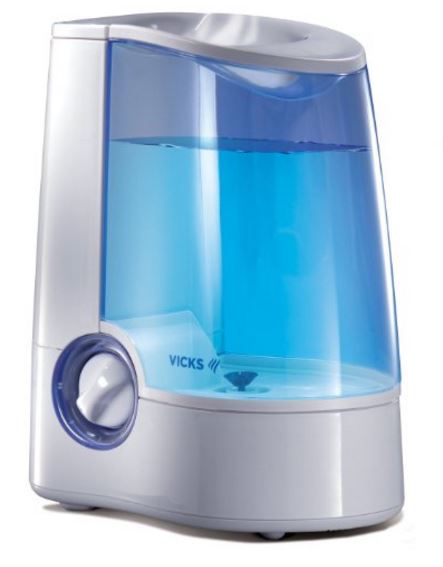
When I opened them up, I expected to find something down inside that would need cleaning, but I was pretty shocked when I saw this! Yuk!
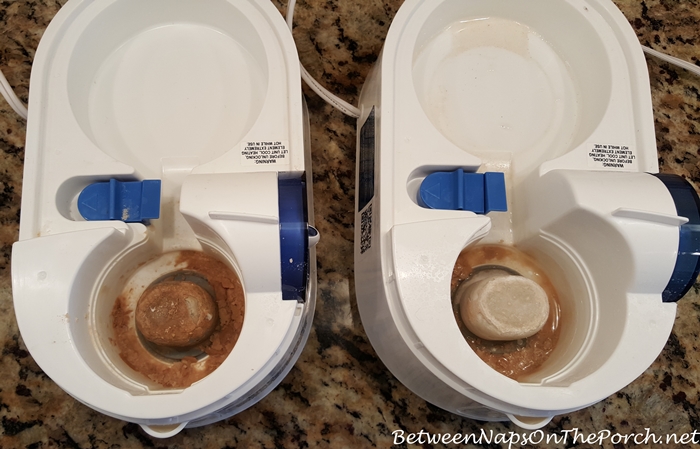
When I purchased these humidifiers, I noticed in the questions/reviews on Amazon, folks were asking how to clean off the hard deposits that form on the heating element inside after using them a month or two. Sure enough, when I opened mine up, I found exactly what those folks had been talking about. Over the couple of months I ran them this past winter, a very, very hard crust had encased the thing that heats up inside to create that warm mist that keeps us so comfortable during the winter. This crust is so hard, you can’t even cut it with a knife!
The humidifier on the left below is the one that ran in my bedroom each night. I noticed it was in a lot worse condition than the one I ran in the office. I guess that’s because it ran all night long while the one in the office only ran as I felt I needed it each day.
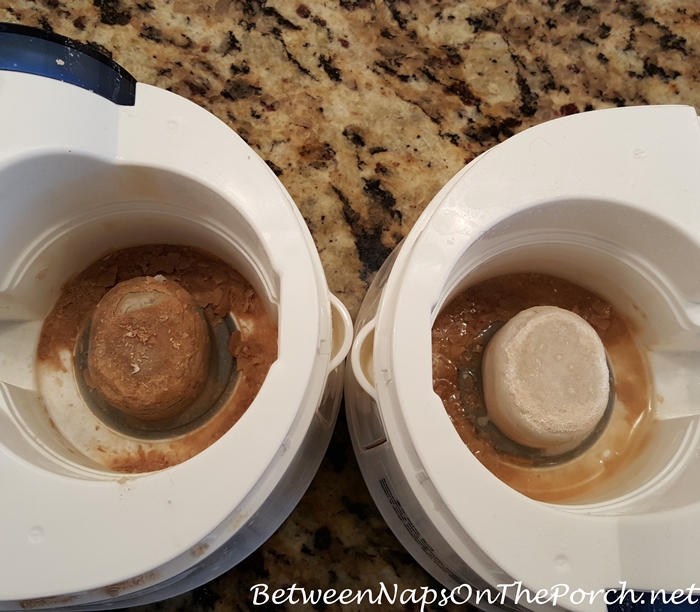
I remembered in one of the answers someone had asked a question about how to clean them. A person who answered recommended soaking the element in a vinegar/water solution about once a month. I decided to give that a whirl. This was the vinegar I already had in my pantry so this is what I used.
Please note: This method worked for my humidifier, but check the manual that came with your humidifier for the manufacturer’s recommendations. I can’t be responsible if this method causes any damage or problems with your humidifier.
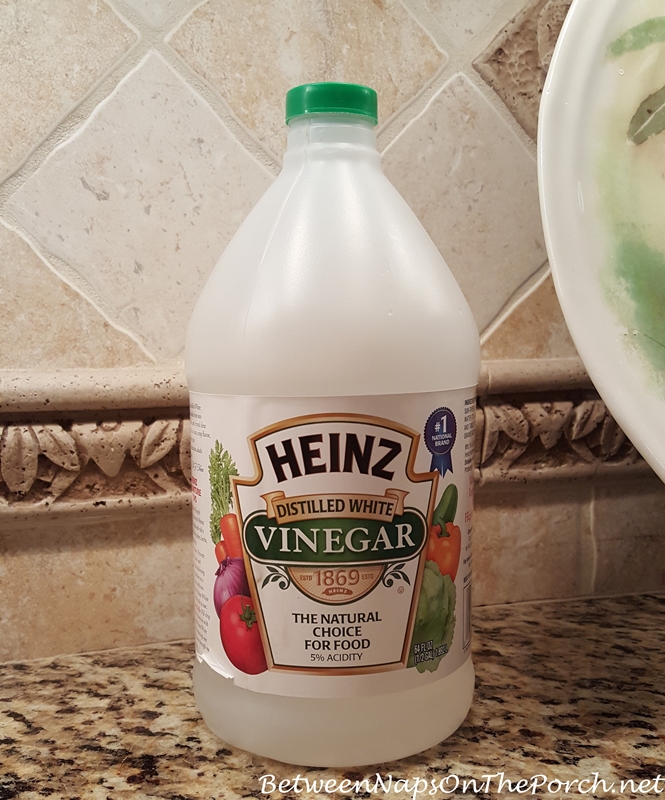
Update on 01-25-19: This is vinegar I now use to clean my humidifiers and it works great. I think it’s a stronger version because it worked better and faster. I ordered it from here: Cleaning Vinegar. It has directions for diluting it when you’re using it to clean, but I used it full strength and it worked great.
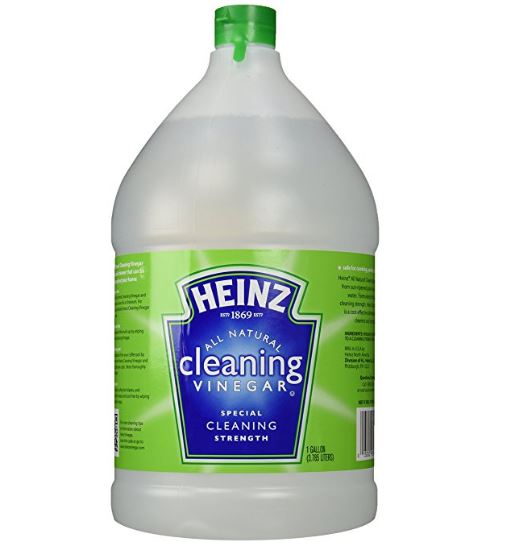
At first, I just poured it in until it was fully covering the heating element. As I stood staring down at this weird little science experiment, I could tell the vinegar was going to work because I could see teeny, tiny little bubbles coming up from the surface of the crusty stuff. Something was definitely happening!
I began to worry that the vinegar could possibly damage the little spring that’s inside the blue slide thingy that helps hold parts of the humidifier in place when it’s reassembled. I figured if vinegar could eat this impossibly hard, crusty stuff off a heating element, it could probably do some pretty significant damage to a metal spring.
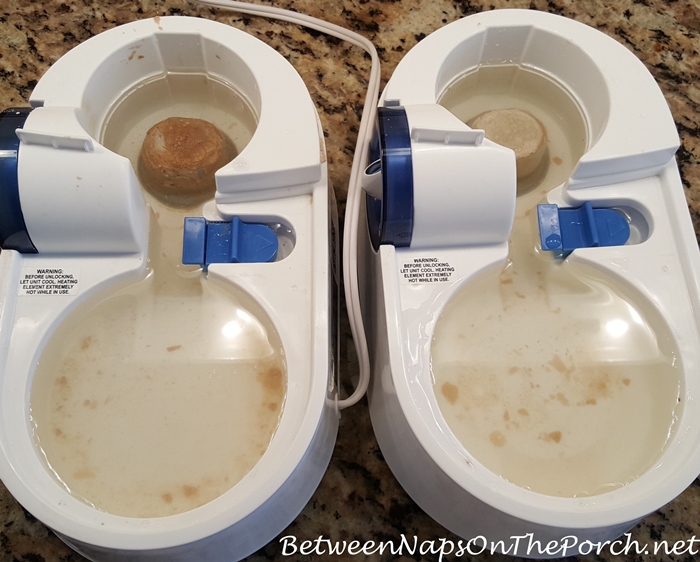
So, I tilted the base of humidifier upward and put a soup bowl under the other end. That forced all the vinegar down to the end where it really needed to be anyway and left the spring and blue slide thingy clear of the vinegar.
In the photo below you can see how the crusty stuff was beginning to look on the bedroom humidifier after about 4-5 hours soaking time. I think the crusty stuff that forms is most likely caused by the minerals in our tap water. I guess when heated up, that’s what they do.
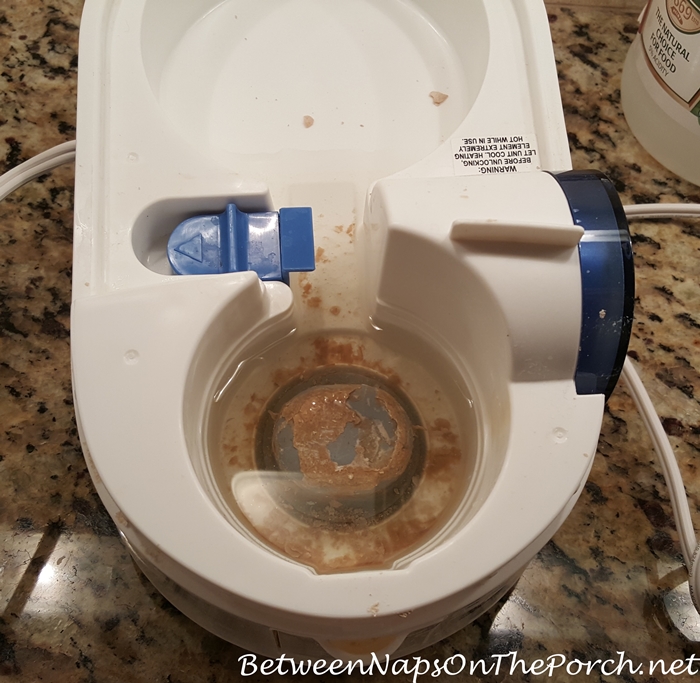
Here’s how the office humidifier was looking after 4-5 hours. Someone in the reviews/questions section on Amazon said the stuff that forms is calcium. Whatever it is, I’m sure it reduces the performance of the humidifier and probably reduces the life of it, as well. It definitely doesn’t need to be there.
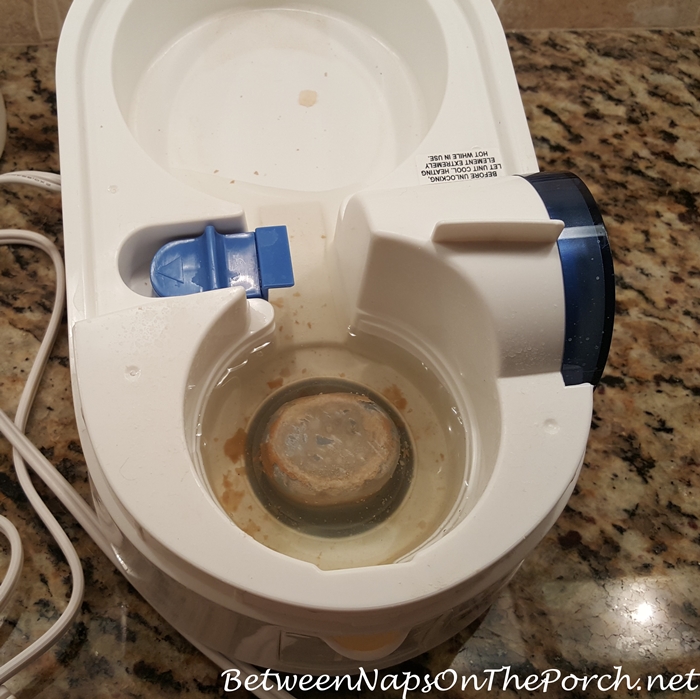
I left the humidifiers soaking overnight and this morning I noticed the bubbling action had stopped. So, I dumped out some of the vinegar and added some fresh vinegar back in. By this afternoon, most of the crusty stuff was gone and I was able to gently scrape off the small pieces that remained. Here’s how the bedroom humidifier looked.
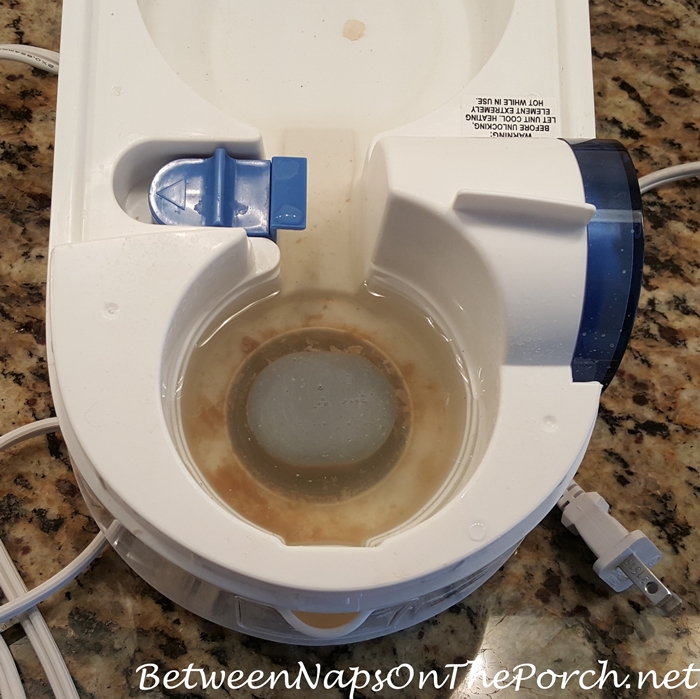
And here’s how the office humidifier looked.
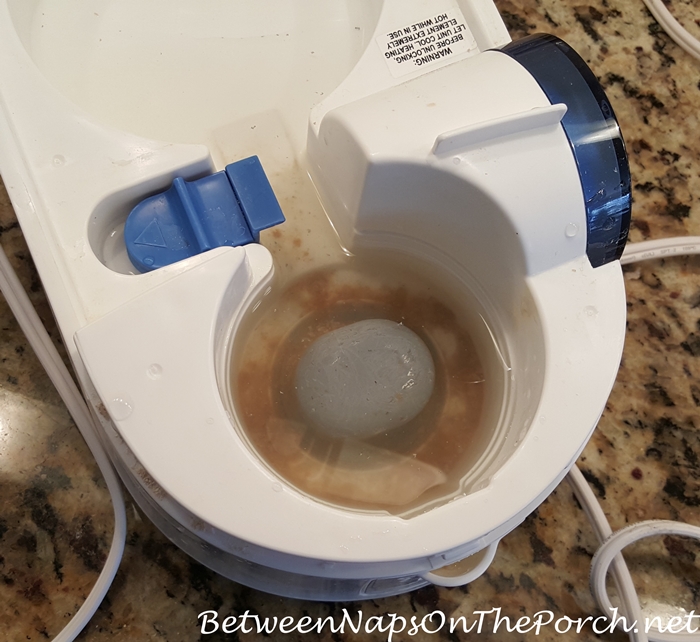
I dumped out the solution and rinsed out the humidifiers and here’s how they looked…much better. If you have this type warm mist humidifier, you may not want to use the vinegar full strength. I decided to just go for it because I’m impatient. I think next year I’m going to do this about once a month instead of running them for 2-3 months and letting it build up so much.
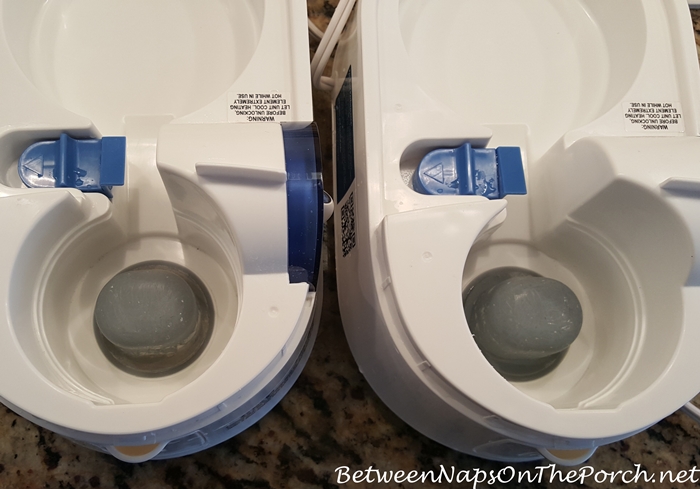
Just to make sure everything was still in working condition, I filled one of the humidifiers with water and turned it on. Do you see the steam coming out the top? It worked great, so all is well!
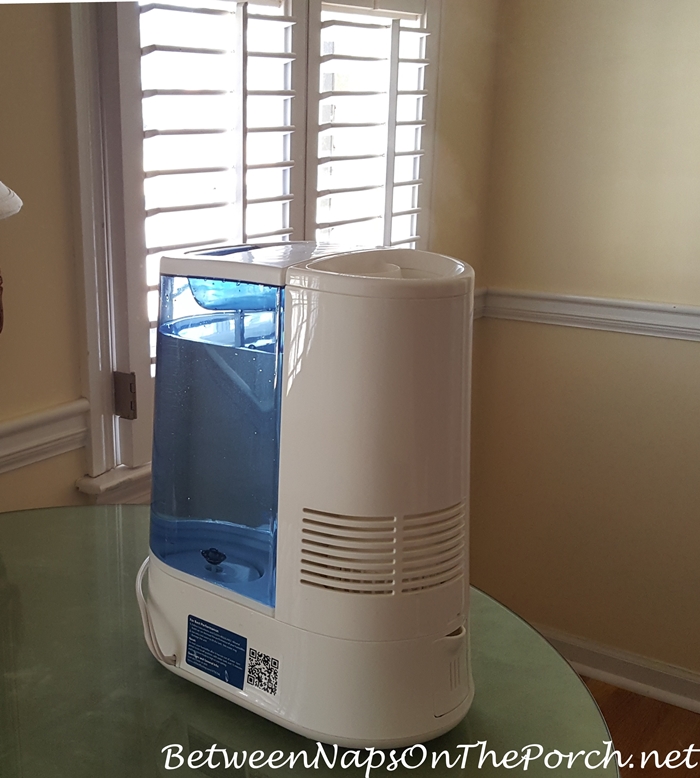
Please note: This method worked for my humidifier, but check the manual that came with your humidifier for the manufacturer’s recommendations. I can’t be responsible if this method causes any damage or problems with your humidifier.
Have you ever had to clean a heating element inside a warm-mist humidifier? If so, what method did you use?





Vinegar is all I’ve ever used and that might be lime deposit rather than calcium.
I bet you’re right, Barbara…it sure was hard to get off!
I use to use my dremel tool to lightly sand that gunk of the heating element of my humidifier. It did ok, but it doesn’t fit to get to the hard to get places near the bottom, so an hour of scrapping with a small electrical flat head screw driver. My way has been the hard way for sure. So have any of you ever tried C L R for removing that calcium build up. That is what I have it soaking in right now, but if it doesn’t work, vinegar will be my next step bc I have to have a humidifier all winter bc the dry air cause bad head aches.
Dremel – genius! It removed the deposits on the heating element that resisted a knife, a box cutter and a screwdriver. I was about to take a hammer and chisel to it (not really … well maybe) when I saw your suggestion. It worked like a dream – thank you very much!
ABSOLUTELY DO NOT USE A DREMMEL (or even a knife!)
The blue/grey surface you see is a teflon coating that can be easily scratched or destroyed by a nail file, much less a dremmel or knife. Once it’s cut, the heating element will start to rust quickly, destroying the humidifier AND creating one *hell* of a fire hazard if the water does leak *into* the element.
Seriously – use ONLY vinegar to dissolve the accumulations, pretty much anything mechanical you do will make things worse, no matter how delicate you try to be. It’s really simple with the bottom-positioned heater cores as shown above.
So true, so true… I destroyed one warm mist humidifier by using a scraping tool that must have cut through the teflon coating and exposed the metal heating element to water. Took a couple of uses before it became hazardous so lesson learned for the current machine. It is economically unfeasible to use distilled water for these units so finding the best chemical cleaner is still an ongoing problem for me. I am currently soaking the element overnight in 10% vinegar and it gets rid of some of the scale. Getting it back to “like new” condition is not a possibility; there will always be some hard scale resistent to chemical cleaning methods.
Lime IS Calcium….
Calcium oxide actually
I had an incrusted heating system humidifier. Forgot all about cleaning it for a few years. Looking inside it I was ready to toss it. It cost to replace $300.
I took your advise soaked in name brand vinegar overnight, and presto.
With very little elbow and a scouring pad, it looks like new now.
Than you for your vinegar advise.
lately the rave has been use coke soda to clean everything. I wonder if that would of worked for you.
lol I’ve heard of using it clean acid off car batteries.
Nice clean job! You can speed up the vinegar process by warming the vinegar in the microwave first. I also use distilled water in my humidifier which is a much cleaner steam. I began to notice a white film on the furniture and discovered it was coming from the humidifier–the manufacturer recommended distilled water to stop the film–much easier clean up in the spring.
If you heat a bird bath in the winter, the warm vinegar is great to clean the heating element! What would we do without vinegar?
Thanks for that info Diane…I didn’t think about heating it up. I kept it away from any furniture but I’ll double check that, too. It definitely made sleeping at night a lot more comfortable.
You’re using a cool-mist humidifier, then, not a boiled-steam one. I had to replace mine as well for the same reason. Beautiful blue bedroom walls, and after a dry winter followed by a muggy summer, there were irregular white patches all over the paint. : (
After thinking about it, I decided that if that stuff ended up on the walls, it also ended up in my *lungs*, along with any bacteria growing in it. Since then, I’ve never used (and never will) anything but a boiling-water steam humidifier – sterilizes and auto-distills. ; ) Much better to need to vinegar-ize the heating element every month or so, than to have that crusty stuff on the heating element end up in my lungs!
That photo is of a warm mist humidifier, NOT a cool mist one. That “bulb” you see is what heats the water and creates steam. It gets extremely hot and “cooks” all the ick in water onto it. It has to be soaked in vinegar (cleaning vinegar is most potent) and scraped.
Like you, I’d NEVER get one of those cool mist things or ultrasonic things. I had one for less than 4 or 5 hours about 18 years ago and I’m STILL scraping “white dust” off of furniture grooves from time to time as I find them. It is a nightmare from hell and if I were a landlord I’d evict anyone seen purchasing a cool mist or ultrasonic humidifier/wall & furniture killer.
It’s absolutely AMAZING that people put those things in their homes! As said, had one less than almost never and when I woke up in morning was STUNNED (and disgusted) to find everything covered in the most tenacious white dust imaginable! STILL finding it in furniture grooves EIGHTEEN YEARS LATER! No doubt it also led to premature demise of electronics that mystery dropped dead not too long thereafter.
To be quite honest, I suspect a simple and very cheap vaporizer, that one can toss in trash and replace every year, might be the better deal. I have several “warm mist” humidifiers and find them giant PITAs! Sooo sick and tired of cleaning them and dragging distilled water home.
If you’d done your research or read the owners manual it says don’t use tap water
Distilled is best because it has no minerals.
My Crane Classic 2 in 1 Warm Mist Humidifier & Steam Inhaler – Blue & White holds a half gallon of water. A half-gallon of water last only through ONE night’s use. I run it every night for at least 4 months during the winter.
That means I would go through about 15 gallons a month of distilled water costing at least $25+ bucks a month or more! Not to mention the hassle of carting 125 lbs. of water to my car and then to my house every month!
At age 70 living on a fixed income and with out-of-control inflation I have better needs for those $250 bucks! Plus my back will appreciate not lugging around 125 lbs. of weight during the cold winter months! lol
Hello: If you are seeing a “white film” on your furniture, you are using a cool mist machine which nebulizes the water into a very fine spray along with any minerals that are in the water and that white film gets into everywhere air can get. The machine in this post is a warm mist machine which boils the water to steam with no “white film” coming out the nozzle. It’s a trade-off; the cool mist machines are lower maintenance re cleaning but they put that white film everywhere unless you always use distilled water. The warm mist machines use more energy (that little boiler is constantly heating some water) and the minerals in the water get deposited on the heating element. And the machines that use disposable filters cost a fortune to run since the filter picks up all the mineral deposits and becomes useless after a month so that means a new (expensive!) filter at least once a month depending on the hardness of your local water supply. I cry when I think of all the water I pour down the sink from my dehumidifer running all summer when it is the perfect “distilled” water for the winter humidifier to use but where are you going to store a 500 gallons of distilled water in an apartment?
Buy a water distiller. They’re great. Saves you trips to the store!!!
I’ve been cleaning our humidifier this week, too! The directions on mine said to clean it with vinegar once a week, but it was more like once a month when I got around to it!
Yeah, I think I’d be doing good to do it once a month, too.
I have heard that these humidifiers also create mold …and that is bad stuff
to spew in the air. That is why they recommend cold mist humidifiers in
place or else use a disinfectant made especially for humidifiers. Why take
a chance….
I think cleaning it out with vinegar on a regular basis should prevent that. I never noticed any moldy smell or anything. I’ll clean it more often next year. It really made the dry air from running the heat a lot more comfortable.
Alyce, that is what my doctor told me as well many years ago.
Alyce – your info is incorrect! It’s cool-mist vaporizers that produce mold. But none of this makes any difference for those who follow instructions and CLEAN the units, whether cool or warm mist. It’s stagnant water that produces mold. Warm mist is much healthier & more soothing in dry climates or dry homes during heating months.
I use a cool mist humidifier in the winter. I clean it every time I replace the wick (some call it a filter). But even though it (the humidifier) looked clean, after two years I had a buildup of hard mineral deposits in the bottom water trough. It’s so thick I could hardly scrape it off with a knife, so I have it soaking in vinegar to hopefully loosen it enough so I can remove it. About the mold issue. I was replacing the wick in my humidifier about every 6 weeks (until this winter when our city water was unusually hard). Last year I forgot to replace the wick for a couple months, and developed a bad hacking cough. This lasted for a month or so, until I realized that whenever I left the house, I felt better and the cough subsided. When I returned home it started again. Then it hit me. I checked the humidifier wick and realized I hadn’t changed it. It was pretty dirty, and although I didn’t see mold, I’m sure there was mold in it, because within a day after changing it, my cough was gone. Since then I change the wick every 3 to 4 weeks, even if it doesn’t look bad. Wish me luck on removing the hard deposits in the water trough.
You are totally correct! 🙂
I find mold grows with a cool mist humidifier. We don’t use one anymore. I have no trouble with mold in our warm mist humidifier. I know it’s the opposite of what they say. But, that is my experience and we have used humidifiers for about 18 years.
…..if you try using purified bottle water instead of faucet water you should not have the crusty mineral deposit. It works well in spray irons. mjv
Thanks for that suggestion, MJ! I did think about doing that, only thing is, it goes through an entire tank full of water each night, as well as another tank full when I ran it here in the office during the day, so that could get a little expensive, I’m afraid. I just have to do a better job of cleaning it more often.
Yes, distilled water will totally prevent any mineral crust build-up. I’ve tried 50/50 tap/distilled and there is less build-up, but this year I’m using 100% distilled and there is never build-up on the heating element. The only caveat is the cost. We have 2 units and each hold 1 ⅓ gallon & both units are filled at least twice daily. At $1/gallon, the cost adds up. I might go back to 50/50 and just go thru the pain of soaking & use a spare unit during the overnite soak as I will need at least overnite due to the extreme minerals in our tap water!
Oh my goodness Susan, that certainly does not look good. Do you have well water…or did you not check it when you put water in it. We invested on a humidifier on furnace that you can turn on without heat running.
No, it’s city water, not well water. Georgia is supposed to have some pretty well-balanced water…we don’t have to add anything conditioner or anything to our water like some places do. But I guess all water has minerals in it…and they apparently do weird stuff when they come in contact with a heat element. lol I thought about a whole house humidifier, but they are a big job to clean out regularly, or at least they were the last time I checked. How often do you have to clean yours and is it pretty easy to clean?
We had a whole house humidifier installed when we built our house 25 years ago & it never worked as we expected. And no one told us we had to clean it. Live & learn! It’s also a cool water method with spongy filters that get gross. I can’t imagine breathing that without changing them weekly…I hope to hear how the newer one works for you!
The instructions with my iron said to use distilled water to prevent mineral deposits. My husband’s golf cart batteries require distilled water. I would try that next winter.
Thanks, Mary! I do that for my iron but since these humidifiers go through about a gallon a day, I don’t think I could store quite that much water, plus it would run about $30 a month to run them. So, I’ll just need to clean it more often and I think the tap water will be okay if I do that. That is so interesting about the cart batteries!
Susan, it is Aprilaire Humidifier, water panel, we change filter yearly. I love it, no more dry nose in winter, it was costly $500, to get installed, but well worth it for us. Not sure how to send pic. Will go on F.B. to send you pic. what I am talking about. Do not know how else to do it. watch for it tomorrow. This girl is ready for some beauty sleep. :))))
Oh yeah, I’ve heard very good things about Aprilaire! That’s awesome that you only have to change the filter yearly, too…sounds reasonable and doable! $500 isn’t that bad for the comfort it provides year after year. Thanks for that info, Renate!
We talked about getting a humidifier for next winter, and I wouldn’t have thought to clean it until spring, so the cleaning tip is so helpful. I hope the mineral buildup didn’t affect you healthwise.
I didn’t notice anything. I think mold is the thing you have to watch for, that would be bad for sure. I loved it, made such a difference in the comfort level with the heating running this past winter. I think I’ll probably shoot for clean it out every couple of weeks this next winter and hopefully it won’t take very long. I’ll probably be able to let it soak overnight and then be good to go the next morning.
I have never used a humidifier except when sick and it has been years. Is that why my nostrils dry up in winter?
Rose, mine really do and I’m prone to nosebleeds more easily during the winter. It just makes the air feel more comfortable.
Yes. Also, if your air is too dry the lining of your lungs get a bit stickier and germs, bacteria or virus can have an easier time to stick to your lungs and make you sick. When my husband was having copd exacerbations frequently in the winter we were told to humidify the air in our home…especially since we ran the fireplace continually. That was about 10 yrs ago and I’ve been using them every winter since.
We keep 2 pots on the wood stove and several humidifiers on in the winter. I rinse out the dehumidifier every day when I fill it and use vinegar once a week. We have hard water even though we have a water softner
You house sounds nice and comfortable, Theresa. Wood stove sounds so romantic, one of my Aunts had one and it was fun watching her put the wood in when I was visiting.
If you have a Britta or other water filter, it may cut down quite a bit on the deposits from tap water. I use the filtered water from our refrigerator in the coffee maker and have almost no issue with calcium deposits there. We have hard water here, and I use vinegar soaks to keep our faucets and shower heads clean. The vinegar is an acid that dissolves the alkaline calcium (lime) deposits. It’s also useful for cleaning the shower doors or anything else that has build-up.
It did a great job on the humidifier. I’ll have to remember that for shower doors…thanks Anna!
I’ve always used distilled water in this type of appliance and routinely cleaned it once a week, so I have never seen this amount of buildup. Routine cleaning with a vinegar/water solution works well on humidifiers, waterpiks, and various medical equipment that is used daily.
Distilled water just isn’t an option since using it daily throughout the winter, would cost about $30 a month. Distilled water runs about .88 cents a gallon at Walmart and I went through about a gallon a day, I’m guessing. Plus, trying to haul home and store 30 gallons of distilled water a month would be a storage nightmare…don’t think my bathroom closets are big enough. 🙂 Just have to clean it a bit more often next year and good ole tap water should work great.
Hi Susan! I think it must be similar to de-scaling a coffee maker, which is what I did yesterday. I’m like you…if 50% vinegar is good, then 100% must be better! It sure worked for you. Wonder what that water is doing to our insides?!?
I would love a blog on how to clean outdoor patio cushions. My project this week was to give my screen porch furniture a new coat of paint. It all looks so fresh and clean. The cushions are in perfect condition, but they sure need a bath. I found out the hard way with previous cushions they are not machine washable. Now the pollen has started falling in upstate SC, so everything is covered with sheets. . Have a super weekend!
lol That thought crossed my mind, too. I guess our body isn’t heating up all those minerals like a humidifier does.
Roxanne, I was talking with the Vice President of the company I use for my lawn care yesterday and he was raving about something called, Spray and Forget. He said that he used to have a terrible time with mold and mildew on his outdoor curtains that hang from their pergola and on their outdoor furniture cushions. Apparently, you just spray this stuff on and do nothing and it eats up all that mold/mildew. Plus, you can use it on fabric and it won’t hurt it.
I was going to buy it to spray on the front porch steps and on the columns on the front porch, but I couldn’t find it anywhere but on Amazon. I called an Ace Hardware near me to see if they had it and they didn’t, but they had something called Wet and Forget and they said they can’t keep it in stock this time of year. I bought some of it to try on my decks, but haven’t used it yet. It looks like Lowes stocks that, too.
I also ordered a spray bottle of the Spray & Forget on Amazon. It should come in a day or two. From what I read, it doesn’t work quickly, but once it works and the mold is gone, you just occasionally spray it on again and it keeps it gone. You can read more about it here: https://www.sprayandforget.com/
I’m hoping it will keep my front porch columns clean.
Also, you’re not supposed to let pets walk through it while it’s wet, so keep that in mind if you spray it on a sidewalk or deck.
Wow, that sounds like a miracle solution! My columns and porch swing get really mildewy too. I’m going to look for both of those products. (My sister is having 3 kidney stones removed this week, so maybe those minerals really don’t go through as fast as we hope!)
That residue happens in your humidifier because as the tap water boils to create the steam, there is evaporation and the minerals that cause limescale (calcium, magnesium, carbonate, and sulfate) remain and become even more concentrated. The process that distilled water goes through removes the minerals that cause lime scale so that’s why distilled water is generally recommended. Other bottled waters are not a substitute for distilled water. In fact, some bottled drinking waters even have minerals added for our bodies’ benefit. I use distilled water in my iron, steam mop and even my Keurig coffee maker but if the cost is prohibitive for you, an alternative would definitely be frequent cleaning with the white vinegar. Otherwise, if the high mineral concentrations build up enough, your humidifers (or any other appliance that uses water and heat) will eventually plug up.
The Wet & Forget from Lowes is great. We use it each spring on our concrete front porch, the outdoor wicker furniture and the vinyl siding on our daughter’s home. Although you don’t have to pressure wash first to use the Wet & Forget, we do simply because we get instant results. Then we spray on the Wet & Forget (no rinsing) to keep the mold/mildew at bay. If you don’t pressure wash first, the Wet & Forget will still work to kill the mold/mildew but it does take time.
Hello. Your comment on the mold products made me wonder if it can be used on real wood decking?
Susan, I envy you! Even though today is officially the first day of Spring; where I live they are forecasting light snow flurries for the next three days. (As the say,”in like a lamb and out like a lion” … ☺.) Regarding your humidifiers, so glad that the vinegar worked and again where I live most furnaces are equipped with them so I myself have never experienced having a portable one. HAPPY SPRING BTW! -Brenda-
P.S.: Re your proposed bathroom upgrades. I am currently in the midst of doing four of mine and shall add; really reconsider having a free standing soaker tub (for a multitude of reasons). Shan’t go into detail now and shall leave that for a later date if or when the topic is open for discussion.
Brenda, definitely would love to hear more about the soaker tub. I doubt I’ll do that for the hall bath since it will be a “kids” bath for most families who live here and will need to be a bath/shower combo since that’s a small bath, but am very interested in a soaker tub for my master bath. So would love to hear any suggestions. I’m leaning toward the type that sits on a pedestal…not crazy about the look of the slipper tubs. I originally thought I wanted a claw foot when I thought about it years ago, but I love the look of the tubs that slope upward on both ends and sit atop a small pedestal. They just look so finished with the little pedestal underneath. I’m just starting to plan though so welcome suggestions! 🙂
I have a funny story to share about using a humidifier. When my son was very small we went to visit my mother. He was getting over a cold and was still congested, so I brought the humidifier with us to use in the bedroom. The next morning when we woke up the whole room was damp. The furniture was wet and the wall paper was peeling off the walls. The sight of the whole room with bubbled paper rolling off the walls was horrifying. Luckily we were able to roll the paper back up the walls and get it to stick. Needless to say, that was the last time I used a humidifier.
Moral of the story: Be careful using humidifiers in wallpapered rooms! 🙂
This is exaclty how I clean mine and I do it about once a month during the wintrer months!
This is the vicks Vaporizer, not humidifier since humidifiers let off cool mist rather than warm (thus the need to heat up). But other than that, I’m glad that trick works after a month or two… I’ve been doing it once a week, soaking a paper towel in vinager and wrapping it around for 6 to 8 hours then scraping it with a bendable knife. Soaking it really makes it melt away huh?
Thanks!
They call it a “Warm Mist Humidifier with Auto Shut-Off”where I purchased it here: http://amzn.to/2edxYh4
So I guess humidifiers can let off a hot mist, too. Yeah, soaking worked, it just took a while. I was really glad it worked! You’re smart to do it more often! I’ll definitely be using them again this winter, made a huge difference at night and in my office. I just need to clean them a lot more often. lol
Did u notice that the mist or Vick’s inhalant wasn’t as strong as it was when u first started using it? I noticed the medicine really strong the first night but the last few nights I haven’t been noticing and change. Just thought maybe u could kinda help me figure out what’s going on.
I only used one of the little menthol medicine pads that came with my humidifier, still have the other sample one around heresome where, so I really haven’t had much experience with using that feature. I just use mine for the warm mist to add moisture to the air. After I cleaned it, it seems to put out as much mist as it ever has. You may want to read some of the reviews and answered questions on Amazon to see if anyone else mentions having had that issue. I have my two humidifiers going again this year and so far they are doing well. But I don’t use the medicine pads with them. I wonder if your nose has just gotten used to the smell? I know they say that we become “nose-blind” to smells we are around on a regular basis.
It’s called your senses getting use to it. It will get to where you won’t smell much of it at all, but when other people come in your home, the vicks smell will burn their noses because you like most folks will ad more vicks because you can’t smell it as well anymore.
Oh my goodness! I’ve been fighting these granite-hard deposits for years. I’ve even had to throw away a couple of humidifiers because I couldn’t get the gunk off and they ended up causing the motors to burn out, rendering the units useless. My dad used some kind of mechanical wire brush to get in there and cut the stuff off. It did work, but needless-to-say, the original coating on the heating element came off, too, and I was left with a very shiny, very metalic-looking surface where one did not exist before. If vinegar is all it takes to get rid of this stuff I’ll be amazed. Going to try it immediately on my current unit.
Cindy, let it soak over night. If it’s really bad, it may need to soak for a couple of nights. It worked great on mine, hope it works for your humidifier, too.
Thank you, Susan. I have two small humidifiers. One worse than the other. I let them both soak last night. I need to do the worse one again, but the other came out great! Hoping a second soak will do the trick. Am pretty amazed at what just straight vinegar has accomplished so far!
the instruction manual says once a week and I can see why I just took mine apart to clean it after using it for a couple of weeks and it was pretty scary lots of lime and rust I was able to wipe out the loose stuff with a damp paper towel then used a plastic dental pick to loosen up the stuff on the warmer and pic it off in chunks It didn’t get it all off but enough it should work a little better
I’ve been cleaning once a month this winter and that’s worked great. I live in Georgia so the water may have less minerals, etc… than some other areas. Just soaking overnight seems to be enough if I do it once a month. I know I’d never take the time to do it once a week, I’m doing good to remember once a month.
Theres, I just realized that I wrote I had been cleaning them once a week. I meant once a month! lol Sorry if that was confusing! 🙂
That is the same brand I have, the thing will stop working and I get the red light meaning it’s out of water or something. I normally scrape it off with a butter knife but this year it’s not budging. I tried the vinegar but I was too impatient and dumped it after an hour, I will do it again and let it soak overnight.
Yeah, it has to soak overnight. And if it’s really thick, I’ve found it’s helpful to soak it a couple of days. The vinegar definitely works, it just takes a couple of days if it’s encrusted really heavily with mineral deposits. I just cleaned my two humidifiers again a couple of days ago, and they only had to soak for one night since I do it about once a month now. Once it’s done, I take a scrubbing sponge and use it to scrub away any small left over pieces that are still stuck.
Just to let everyone know you are not supposed to scrape the mineral deposits off with a knife or any hard or sharp object, because you can harm the heating element…only vinegar and a toothbrush if needed..if you clean it once a week you won’t have this problem and your product will work great for years to come:-)
I”m happy for all who used vinegar and got good results in cleaning humidifiers. Mine never got clean despite soaking for several days- changing the vinegar a number of times. Any suggestions?
Carole, when I was soaking mine, after it had soaked for about 12 hours, I chipped a little of the stuff away so the vinegar could get in there and work. Just make you’re using a good name brand of vinegar. Mine was in terrible shape but it did work. Also, after it soaks for about 12 hours, pour it off and add some fresh vinegar. I found that helped, too.
My favorite humidifier as well! Love the before and after. Cleaning mine right now, hubby has the flu. 🙁
Hope he gets better soon, Lissa! No fun being sick.
Thank you so much for this post. I’ve been cleaning the water basin with vinegar but neglecting the inner parts. When I read your post, I immediately got my Vicks humidifier, (I have the same kind) and check the innards. It was full of calcium, everywhere. Most of it came off with a little soaking and a soft toothbrush but the blue part in the middle will have to soak overnight. Your simple yet complete instructions with clear pictures made my task easy and anxiety free. Thanks again. Tara
Thanks, Tara…glad this helped. It may take a bit more than just soaking overnight. Tomorrow morning, dump out the vinegar and clean off as much of the calcium/mineral build up as you can. If there’s still some left, just add more vinegar and let it soak a while longer. That’s what I had to do since mine was so badly built up on the heating element. The vinegar will work, it just may take a few soakings to get it all off. This year I’ve been cleaning my humidifiers once a month and that has worked out well. I have found that an overnight soaking is all they need when they are being cleaned at least once a month.
Most of mine came off over night, just a few stubborn fragments are left but I can see it would be a lot easier to do this every month.
The calcium all came off but it softened the coating on the heating element and some of that came off also. My humidifier is a bit old so maybe that’s why. I hope this still works ok. Using a humidifier in the bedroom has definitely helped my breathing and I think I will use it during the day in my working area. I use filtered water from the tap.
Ummm, I wonder if it is due to being older. I’ve cleaned mine 4 times now this way and it hasn’t effected the cleaning element. Maybe you’ll need to dilute the vinegar with water each time. Mine had a few stubborn pieces, too…but I was able to get those off by lightly scrubbing it. You may eventually have to replace it, not sure how long these humidifiers are supposed to last. Yeah, it made a huge difference in my sleeping at night, definitely having one here during the day in my office.
I have the same Vicks humidifier. I rinse the whole unit out each night and soak the heater element in vinegar and baking soda (or is it the baking powder–the one in the little yellow box) once a week for a few hours and once a month for at least two days straight for a deep clean. Adding the baking powder to it gets it nice and fizzy–just gives it a cleaning boost. I use my humidifier year round, every night, and about 6 feet from my pillow. I have dry eyes (ughhh, contact lenses!) and it’s the only thing that helps. I don’t want to use medicated or OTC drops the rest of my life so it’s the humidifier every night!
Thanks for those tips, Colette! Good to know that the baking soda helps!
I have this same humidifier and just keep buying them every few years as I run them all year long…I have 2 and clean them out with straight vinegar every week – hard water where I live and mine crust up within a few days even using filtered water. Weekly Saturday morning ritual at my house – soak the humidifiers most of the day.
I have mine running right now, got it out a couple of weeks ago for the fall-winter season. I only run mine during the winter, and despite having fairly balanced water here in the Atlanta area, it does start to crust up pretty badly after about a month. So I end up cleaning it every 4-6 weeks. I don’t think I would like having to do it weekly, but it’s worth it for the comfort it brings! Also a lot cheaper than buying distilled water or whatever water one would need to buy for it. That cost would add up really quickly.
All this long term soaking is unnecessary.
Just fill the area around the element like you have done, with 100% vinegar (don’t dilute it), tilt it up a little, set it outside and turn it on with the little tower piece attached so that gets vinegar steamed.
It’ll be ready in 15 minutes.
And while the vinegar is effective on the build up, it’s not going to harm any metal springs. It’s only around 5% acidity.
This is a good idea if you catch it early enough, but in my case, it crusted up before I noticed that this would even happen.. and it plugged up, causing the unit to turn itself off as though there’s no water in the tank. But I probably could have taken just enough off to get it working again. However chipping the calcium off myself only took about a minute, so I didn’t need to use vinegar (which I didn’t have on hand at the time, thus why I was even chipping at it).
Never ran a humidifier outside before, but that was brilliant! Just cleaned two of these Vicks WarmMist humidifiers like that this afternoon. Very satisfying results!
I have the same Vicks Humidifier. I was searching for what it was building up on the unit, but knew it was either lime or calcium. Doesn’t really much matter, but for some reason I wanted the info, and this blog post came up.
Anyways, I had mine not even 2 weeks, and had a hard crust of lime/calcium on mine. I knew baking soda + vinegar would work (that’s the answer, imo), but I’m out of vinegar.. so I just used an sos pad, at first, then chipped away at it with a butter knife. It came off in big chunks fairly easily, so it wasn’t too bad. But the easiest way would be Vinegar+Baking Soda. Put the vinegar in first, and slowly add baking soda. The two will react VERY quickly and bubble over quite fast if you’re not on the ball with how much you put in.
It’s not recommended that you clean the heating element with a knife or steel wool pad. You can damage it. The owners manual suggests using a soft brush. I use an extra toothbrush for cleaning.
Thanks for the photos…I just cleaned our new Vicks Warm Mist for the first time and was a bit upset at the scaling on the heating element! I had not cleaned it before leaving over Christmas. Sitting over that two weeks probably didn’t help. Most discoloring came off with hot water and a nylon scrubbie. I do think the idea of soaking a paper towel in vinegar and wrapping it around the heating element might help. By the way, I was able to remove the plastic “cone” at the top and found more gunk there. We do have hard well water, also, which is probably the cause. Thanks for your tips!
I have two of these exact humidifiers as well. I honestly love them and think they work great. My daughter gets sick a lot less when we use them regularly. I swear that girl catches EVERYTHING. Anyways just a tip, if you clean these humidifiers once a week, the gunk comes off super easy and saves a lot of time and elbow grease. Well but I let one of them go a little longer than usual and it is awful hard to get that junk off!!
I dissassemble and clean my humidifier every morning and clean it with vinegar and bleach once a week (per manual instructions). So far I’ve had some mineral deposits on the heating element, but none of that brown gunk (doesn’t look healthy). I’ll have to try the overnight soak when I plan to store it away.
The manual says to use vinegar and bleach together?!?!??
That would yield a whole lotta’ dead customers.
I love this article. This information is exactly what I needed. I even have the same humidifier. And love all the photos. Thanks!
I did a similar trick. Mine had A TON of calcium deposits so I knocked what I could into the trash can. Then I fit a wash cloth around the element and soaked it with full strength vinegar. It’s worked great and very quickly so far, it’s only been about 20 minutes and 70% of it is gone. I just added more vinegar to the rag and hopefully it will be done soon so I can use it tonight. Thanks for the tips!
I think I will try this as I clean man this winter. That sounds like a great idea and even faster! Thanks, Charlotte!
I had one that was heavily crusted. I used 1/2 cup white distilled vinegar, heated for 1 minute and added 1 tablespoon dawn (blue) dish soap. Mixed them together and poured on element. Soakedfor approx 35 minutes and it was falling off in chunks. Worked perfectly. I use this mixture in a spray bottle for my showers and tubs
Thank you! This worked like a charm!!
Hey I have the same humidifier and I read that same Amazon comment…. After I had already angrily taken a knife to the heating element buildup. The commenter had really warned, twice, that it was important the heating element does not get scratched. Mine is a little – should I toss it?
You probably should check with the manufacturer to find out for sure. Mine is scratched a little but not too bad and I have continued to use it. But I would still check with the manufacturer to make sure before you use it again. I wouldn’t want to recommend that and then you have an issue or problem.
THANK YOU SO MUCH!!!!! I finally cleaned mine for the 1st time (I’ve had it a few years but don’t use it as often as I should) I took it apart (which I didn’t know you could until a YouTube video) and I thought it was broken I had what seemed like concrete all around the gray part and I thought that the broken peices meant it was ruined so glad that junk wasn’t a part of it..
So glad it worked! I know, the mineral deposits that form on the heating element do look like concrete! I recommend cleaning it at least once a month if you’re going to be running it every day. That’s about how often I clean mine now.
Definitely will be cleaning it more, apparently when I got it I didn’t read the instructions (I was sick and needed relief) so I didn’t know about cleaning it.. it does seem that maybe some of the rubber/plastic or whatever the gray stuff is came off in the mineral deposits.. I hope it is ok.
It may be time to replace it. I have two and one of mine is a little scraped looking, but overall is fine. If a lot of the gray stuff came off on yours, it might be safer to just replace it with a new one, then just clean that one on a regular basis. I would call the company that makes it and ask what they think. I’m not exactly sure what the purpose of the gray stuff is, but I’d rather be safe than sorry.
It’s standard mineral deposits from using water from tap or otherwise undistilled water. The orange stuff might be iron. Hard to tell unless one can actually touch it (some iron is slimy).
Should be perfectly cleanable with vinegar. Cleaning humidifier is a big PITA, IMO, but not as big as dried out hair, skin, pets that look like they’ve been electrocuted, and ruined furniture (dry is almost as bad as damp).
That’s true! I don’t look forward to cleaning mine but using a vinegar that’s made especially for cleaning really helps the process go a lot faster. It really does help with the “comfort” fact in the wintertime–I so agree!
I thought my water was fairly clean. Kept wondering why that area of my humidifier was getting white/tan crusty film and flakes. I’m cleaning it every day. The tank looks fine, but that underneath part is caked (in what I now guess is calcium) after each night of use..
It’s amazing how fast it builds up on the heating element.
I know it’s been quite some time since the original post, but another option is to use a citric acid (available in the canning section of most grocery stores) solution instead of vinegar. Works just as well, and doesn’t smell your house up. It’s also good for cleaning showers/tubs to remove the scale. A few tablespoons of citric acid in a gallon of water should do the trick.
I have very similar humidifier and it had so much hard brown build up around the heating unit that I thought I had to throw it away. Thanks to your advice I managed to get it all out! I just soaked it in vinegar. Thank you so much!
Hello! This is the method I use for my Vicks humidifier (A different model than yours, but mostly everything is pretty much the same), and it does work for me mostly! Before I EVER cleaned mine, the buildup was so bad that I also did multiple treatments of vinegar, some CLR, and some other stuff I found on Amazon that was supposed to help fight hard water stains. It all eventually worked and now, like you, I clean the heating element portion monthly if not weekly since my sinuses are so sensitive. I did not know about the cleaning vinegar so I added that to my Amazon cart 😉 Thank you for this article!
Yes! I was so grossed out when I just checked the bottom tray, wandering why my red light kept coming on. Sooo gross! Anyways, I found your article after the fact, so I will try this next time. I rinsed mine under really hot water and it flaked away within seconds!
Grown sick and tired of lugging gallons of distilled water home and the EXPENSE of such I simply decided to go back to basic chemistry knowledge.
Water here is 7 to 9 grains of hardness (Lake Michigan) and the tank is about 1 gallon. I add 1/4th cup white vinegar to each refill and I only have to clean the heating element (that bulb looking grey thing) and wipe out the insides every four or five fills.
The vinegar is barely detectable in the air if at all. I don’t smell it.
BONUS!!!!: Vinegar kills MANY airborn viruses and other contaminants such as mold! A bit of vinegar in that humidifier means less transfer of airborn bugs and without all the CRAP that people are buying in this “pandemic”.
BUT, if you smoke in your house not a great idea as vinegar will grab the tar and attach it. That’s why shallow dishes of white vinegar in the home of a smoker will greatly reduce lingering odor and wall/furniture stick of the yellow component of cigarette tar. It literally sucks it out of the air. IF you put it into a warm mist vehicle, such as a humidifier, I can only envision the vinegar grabbing the tar and dispersing it worse than if you were just puffing without humidifier. Which, BTW, IF you ever get cigarette tar on walls and/or residual smell thereof, straight vinegar will not only clean it off but beautifully prime the walls for new paint.
I grew up in home with chain smoking mom of worst smelling, tartiest cigarettes ever created, “Raleigh” (no longer in business…probably dropped over from horrible stench of them as they were WORST ever created :-€ )and only way to get that stuff off walls was with straight white vinegar. Other way was to rip down walls and hire contractor to put new plaster in (not cheap, easy drywall, plaster).
Vinegar saves the day for us all! Our humidifiers are necessary if we desire to not look like walking potato chips with our hair crunching in the breeze and our pets looking like they got electrocuted with their hair standing wildly on end SO simplest solution…get vinegar 😀
lol Great descriptions! 🙂 I never thought about putting some vinegar in the humidifier…thanks for that tip! I grew up around smokers so I know what you mean. Fortunately, no one I know smokes now–so terrible for the lungs.
This guide on how to clean encrusted mineral deposits from inside a Vicks humidifier is a game-changer! The step-by-step instructions and tips for removing stubborn deposits are really helpful. Thanks for sharing this valuable resource!
You can avoid this problem altogether by simply using distilled water in your humidifier. It can usually be purchased at any market but countertop distillers are so affordable these days, it’s helpful to just have one to distill on demand for many other purposes, as well.
Thanks, appreciate that suggestion. I know that would stop the issue, I use distilled water in my iron and my steamer, but I run two humidifiers each day, one in my bedroom at night and one in my home office during the day. So it would get very expensive using approximately 2 gallons of distilled water every day during the winter months. That would be 60 gallons per month to purchase and lug home from the grocery store. So I’d rather use tap water and just clean the humidiers once a month. I’ve been doing that for several years and the humidifiers are still working great.
Susan – I have the same humidifier and have been soaking mine in white vinegar about once a week, but all the crusty stuff does not come off. I’m thinking about buying a new one of the same model — this will be my third — because of the problem. Do you think cleaning vinegar makes a big difference? What about heating the vinegar like some of the comments suggests? Thank you.
I have been using this vinegar and it works really well. https://amzn.to/4big1uf
Sometimes I take a place knife and scratch the surface of the crusty stuff so the vinegar can get in there to work. I try to do the vinegar cleaning once a month so it doesn’t get too thick/bad in between cleanings. That seems to work and normally it will soak off overnight. Sometimes it takes soaking for two nights. Alos, I often pour off the vinegar from the first night’s soaking and add fresh vinegar for the second night–if I have to do it a second night. So far this is working and I haven’t had to throw out any of my humidifiers. They are still working great.
I just ran out of the 45% Calyptus vinegar after the last soaking/cleaning. This time I purchased this one which is a little less expensive but has the same strength: https://amzn.to/47Dc93T . Hopefully, it will work as well. If it doesn’t, I’ll go back to using the Calyptus brand.
I don’t know if heating the vinegar would work, I haven’t tried that since the 45% strength is getting the job done quite well. Hope that helps!
I have the same humidifier and used baking soda and vinegar, but i also didn’t let it sit very long. I had to scrape the crust with a screwdriver and Brillo pad. The company does say to use Distilled water, but I chose to use tap water.